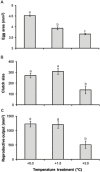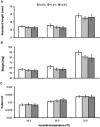Reproductive acclimation to increased water temperature in a tropical reef fish
- PMID: 24823490
- PMCID: PMC4019553
- DOI: 10.1371/journal.pone.0097223
Reproductive acclimation to increased water temperature in a tropical reef fish
Abstract
Understanding the capacity of organisms to cope with projected global warming through acclimation and adaptation is critical to predicting their likely future persistence. While recent research has shown that developmental acclimation of metabolic attributes to ocean warming is possible, our understanding of the plasticity of key fitness-associated traits, such as reproductive performance, is lacking. We show that while the reproductive ability of a tropical reef fish is highly sensitive to increases in water temperature, reproductive capacity at +1.5°C above present-day was improved to match fish maintained at present-day temperatures when fish complete their development at the higher temperature. However, reproductive acclimation was not observed in fish reared at +3.0°C warmer than present-day, suggesting limitations to the acclimation possible within one generation. Surprisingly, the improvements seen in reproduction were not predicted by the oxygen- and capacity-limited thermal tolerance hypothesis. Specifically, pairs reared at +1.5°C, which showed the greatest capacity for reproductive acclimation, exhibited no acclimation of metabolic attributes. Conversely, pairs reared at +3.0°C, which exhibited acclimation in resting metabolic rate, demonstrated little capacity for reproductive acclimation. Our study suggests that understanding the acclimation capacity of reproductive performance will be critically important to predicting the impacts of climate change on biological systems.
Conflict of interest statement
Figures




References
-
- Hickling R, Roy DB, Hill JK, Fox R, Thomas SCD (2006) The distributions of a wide range of taxonomic groups are expanding polewards. Global Change Biol 12: 450–455 10.1111/j.1365-2486.2006.01116.x) - DOI
-
- Poloczanska ES, Brown CJ, Sydeman WJ, Kiessling W, Schoeman DS, et al. (2013) Global imprint of climate change on marine life. Nature Clim Change 3: 919–925 10.1038/nclimate1958) - DOI
-
- Van Der Kraak G, Pankhurst NW (1997) Temperature effects on the reproductive performance of fish. In: Wood CM, McDonald DG, editors. Global warming: implications for freshwater and marine fish. Cambridge University Press, Cambridge. 159–176.
Publication types
MeSH terms
LinkOut - more resources
Full Text Sources
Other Literature Sources

